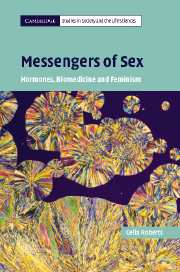Book contents
- Frontmatter
- Contents
- List of figures
- A message to readers
- Acknowledgements
- Introduction: feminism, bodies and biological sex
- Part I HORMONE HISTORIES
- Part II HORMONAL BODIES
- Part III HORMONE CULTURES
- 4 Elixirs of sex: hormone-replacement therapies and contemporary life
- 5 The messaging effects of HRT
- 6 Hormones in the world
- Conclusion: hormones as provocation
- References
- Index
4 - Elixirs of sex: hormone-replacement therapies and contemporary life
Published online by Cambridge University Press: 22 September 2009
- Frontmatter
- Contents
- List of figures
- A message to readers
- Acknowledgements
- Introduction: feminism, bodies and biological sex
- Part I HORMONE HISTORIES
- Part II HORMONAL BODIES
- Part III HORMONE CULTURES
- 4 Elixirs of sex: hormone-replacement therapies and contemporary life
- 5 The messaging effects of HRT
- 6 Hormones in the world
- Conclusion: hormones as provocation
- References
- Index
Summary
Internationally, millions of women take sex hormones in the form of pharmaceuticals to address a range of conditions: unwanted fertility, menstrual problems, infertility and menopausal symptoms. This extensive consumption of hormones takes place at a time in which taking multiple drugs ‘for life’ is a widely accepted practice; a mode of life promoted strongly in the United States where pharmaceutical products are advertised on television, radio and magazines (Dumit 2002, 2005). Particularly as hormone-replacement treatments for menopausal women, hormones constitute a highly profitable business: in 2001, for example, one brand of hormone-replacement therapy (HRT) was the best-selling drug on the global market, making US$2 billion profit for its manufacturer, Wyeth (Seaman 2003: 106; Morrison 2004). Named Premarin™ after its source, this drug is made from urine collected from 40,000 pregnant mares controversially stabled for this purpose. Debates about the provenance of this drug are entered into by animal rights campaigners with much intensity, foregrounding links between women and female animals; between human and non-human animal reproductivity. These debates also highlight the surprising economic and symbolic flows through which hormones gain and confer biovalue (Waldby 2000).
This chapter theorises the exogenous hormones of HRT as messengers of sex. It asks how taking HRT came to be an accepted part of life for millions of menopausal women in the wealthy west whilst remaining unavailable for many women living in other parts of the world.
- Type
- Chapter
- Information
- Messengers of SexHormones, Biomedicine and Feminism, pp. 111 - 136Publisher: Cambridge University PressPrint publication year: 2007

